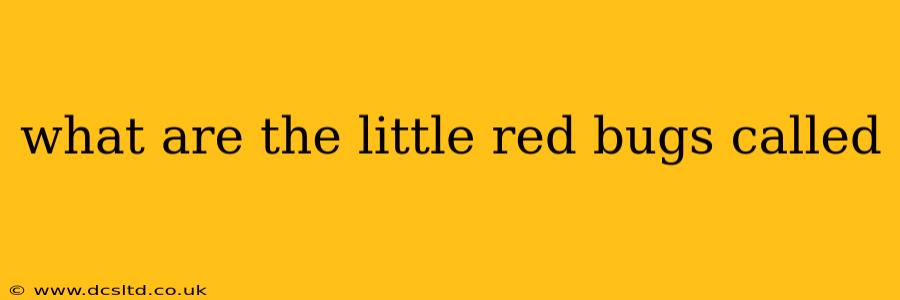What Are the Little Red Bugs Called? A Comprehensive Guide
The term "little red bugs" is incredibly broad, encompassing a vast array of insects and arachnids. Pinpointing the exact species requires more information, such as location, size, shape, and behavior. However, we can explore some common culprits and delve into their identifying characteristics. This guide will help you narrow down the possibilities and hopefully identify those pesky little red invaders in your home or garden.
What are some common types of small red bugs?
Many different insects and arachnids appear red at some point in their life cycle. Some of the most common possibilities include:
-
Spider mites: These tiny arachnids are often red or reddish-brown and are common pests on plants. They are so small they can be difficult to see without magnification. Look for fine webbing on your plants, a sign of their presence.
-
Red Velvet Mites: These mites are bright red and often appear in large numbers on lawns or in leaf litter. They're harmless to humans and pets but can be alarming due to their sheer number.
-
Crimson Clover mites: These are found on clover and are often seen during the warm months. They are similar to spider mites in size but may be more vibrant red.
-
Certain species of beetles: Several beetle species have red coloration, both in their larval and adult stages. Ladybugs (ladybirds) are a well-known example, though they often have spots. Other red beetles might indicate a specific region or habitat. Details like shape and size would greatly assist identification.
-
Red ants: Several species of ants display red or reddish-brown coloration. Knowing their behavior (e.g., forming trails, building mounds) can aid identification.
What are the little red bugs in my house?
Finding red bugs inside your home requires considering different possibilities than outdoor bugs. Common suspects include:
-
Carpet beetles: These small beetles are often reddish-brown and their larvae can damage carpets, upholstery, and other fabrics.
-
Stored product pests: Certain insects infesting stored food items, such as rice or flour, can be red or reddish-brown. Check your pantry for signs of infestation.
-
Rust mites: While primarily found outdoors, rust mites can sometimes find their way indoors. These tiny pests affect plants, leading to discoloration and damage.
-
Booklice: While typically light brown or grayish, some variations might show a reddish hue. They feed on organic matter like bookbinding, wallpaper paste and other similar materials.
What are the little red bugs in my garden?
Many red insects inhabit gardens. Precise identification is crucial to determine if they are beneficial or harmful to your plants. This is where observation is key. What plants are they on? Are they feeding on the plants? Do they have any specific characteristics? Consider the following:
- Red spider mites: As mentioned, a common plant pest.
- Aphids: Some aphids species have red coloration.
- Leafhoppers: Certain leafhopper species are red or have red markings.
How do I get rid of little red bugs?
The best method for controlling red bugs depends entirely on the specific species. Broad-spectrum insecticides should be avoided whenever possible, as they can harm beneficial insects.
For plant pests, consider options such as insecticidal soap, neem oil, or other targeted pest control measures. Always follow product instructions carefully. For bugs in your house, identify the source of the infestation and address it. This might involve thorough cleaning, discarding infested food items, or contacting a pest control professional.
What do little red bugs bite mean?
Whether or not a small red bug bite is cause for concern depends on the species and your reaction. Most are harmless, causing only minor irritation. However, some might cause more severe reactions, especially in individuals allergic to insect bites. If you experience significant swelling, pain, or other concerning symptoms after a bite, seek medical attention.
Identifying the specific type of “little red bug” is the first step towards understanding its behavior, potential threat, and appropriate control measures. Remember to always observe carefully and document characteristics like size, shape, location, and behavior to help narrow down the possibilities. If you are unsure about identification or control, consult with a local entomologist or pest control professional.
